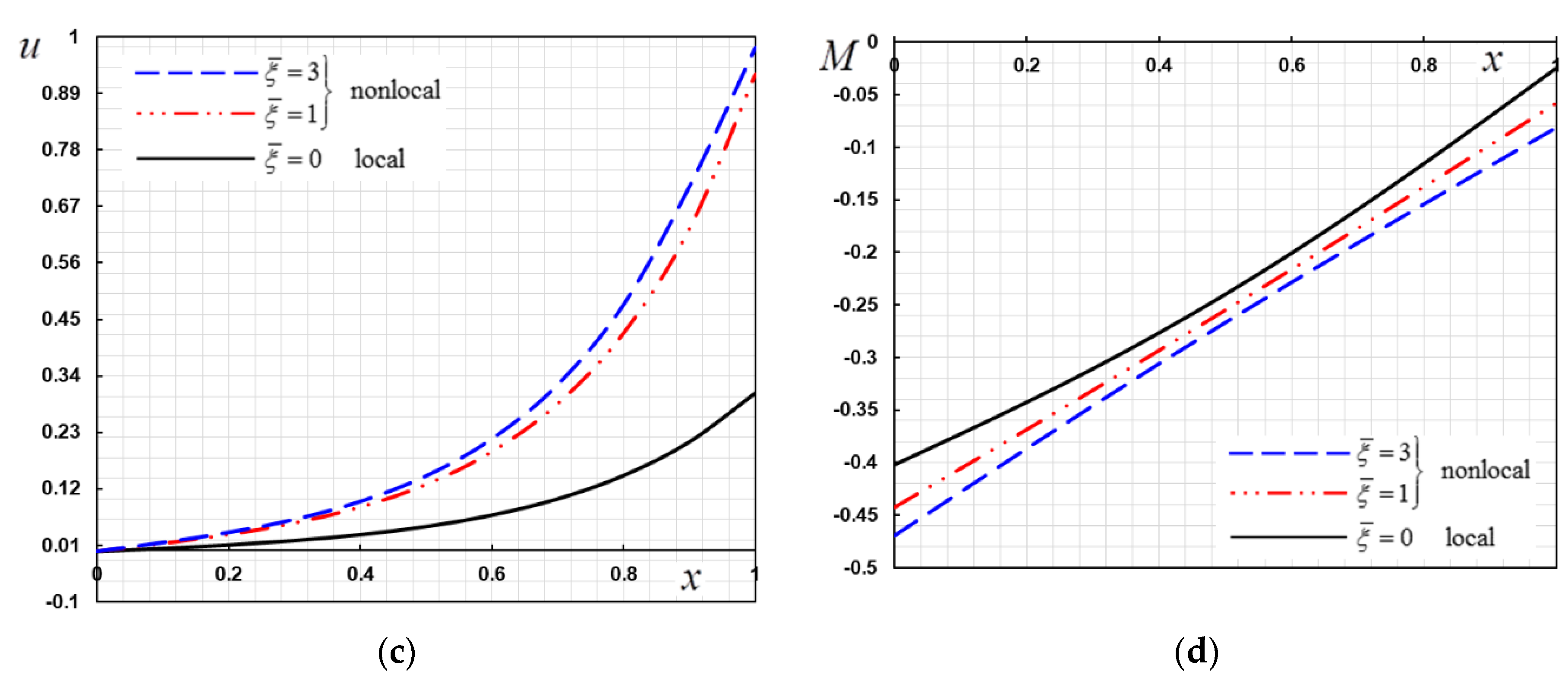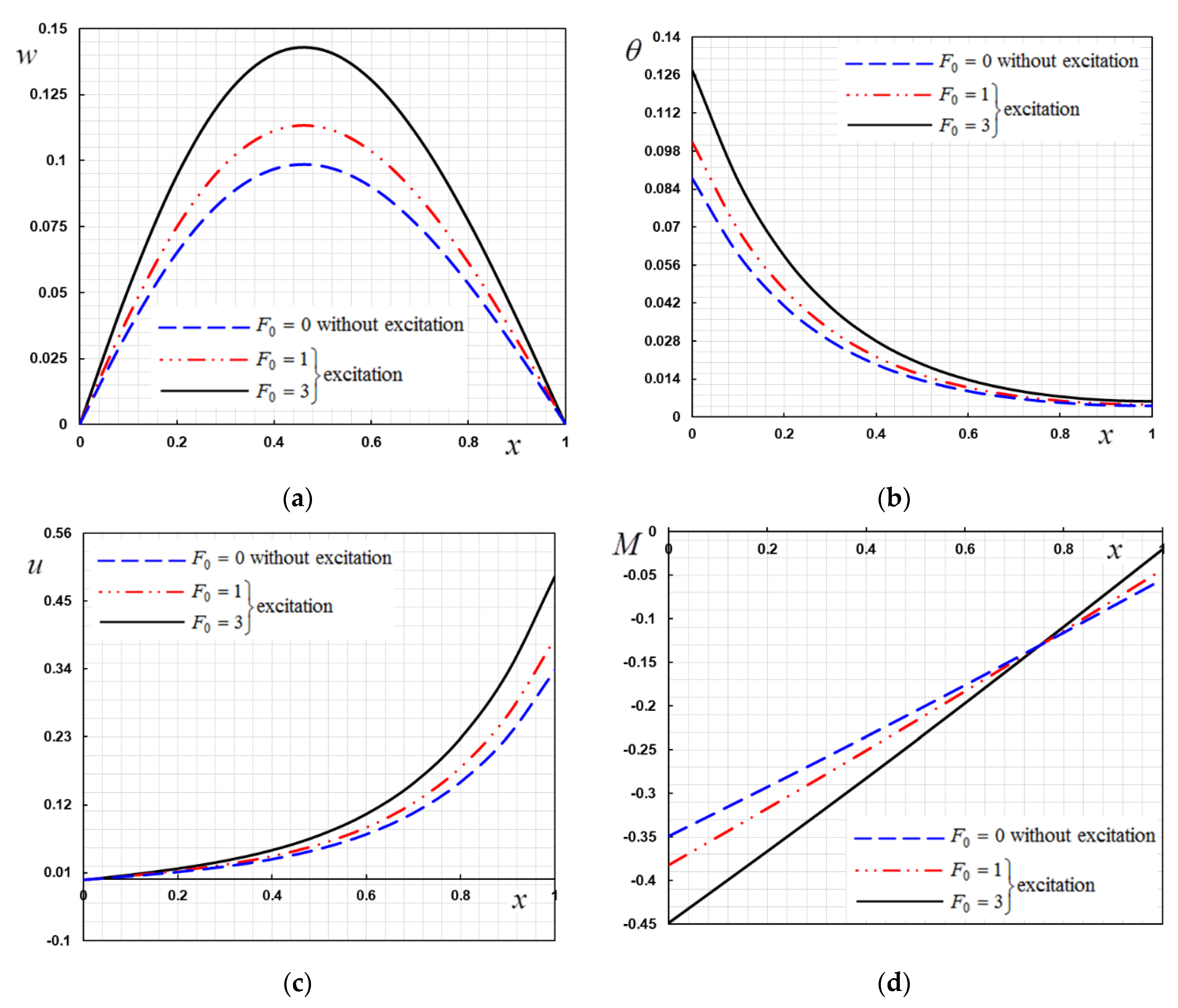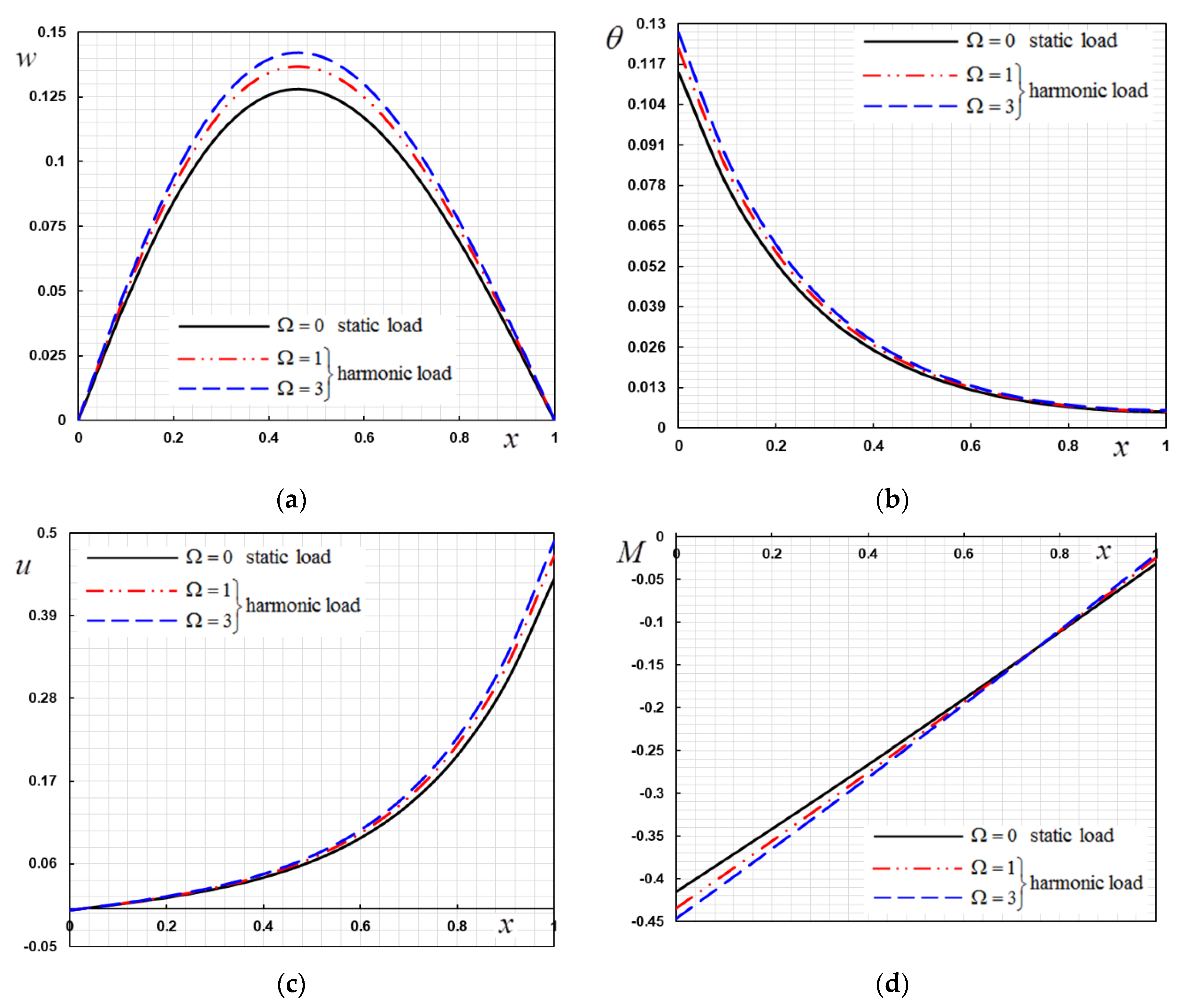The Size-Dependent Thermoelastic Vibrations of Nanobeams Subjected to Harmonic Excitation and Rectified Sine Wave Heating
Abstract
1. Introduction
2. Theoretical Problem Formulations
3. Solution of the Problem
4. Boundary Conditions
5. Solution in the Transformed Space
6. Numerical Results
7. Conclusions
- -
- The magnitude of forcing excitation, the nonlocal parameter, the frequency of the external excitation and the frequency of the rectified sine wave heating field have a considerable influence on the response of the system behavior.
- -
- When an external harmonic excitation is applied to the nanobeam, the field quantities are more sensitive to excitation frequencies.
- -
- The increase in the value of the forcing excitation causes an increase in the thermodynamic temperature values, displacement and in the lateral fields, which is evident in the peak points of the profiles.
- -
- The results in this study may find applications and requests in the development and design of resonators due to thermal environmental loading.
- -
- The vibration of the heat response of nanobeams can vary by changing the size of the external force and thermal loads without having to change any other engineering and physical parameters of the nanobeams.
- -
- The temperature dependence of the frequency of the resonance of resonator devices can be utilized to design and create precision thermometers that are not at all suitable under high sensitivity to rectified sine wave heating and harmonic loads.
Author Contributions
Funding
Conflicts of Interest
References
- Mohammedi, S.; Hassanirad, A. Applied and Theoretical Cantilever Beam Free Vibration Analysis. World Acad. Sci. Eng. Tech. 2012, 61, 1619–1622. [Google Scholar]
- Younis, M.I. MEMS Linear and Non-Linear Statics and Dynamics; Springer: New York, NY, USA, 2011. [Google Scholar]
- Allameh, S.M. An introduction to mechanical-properties-related issues in MEMS structures. J. Mater. Sci. 2003, 38, 4115–4123. [Google Scholar] [CrossRef]
- Abouelregal, A.E. Response of thermoelastic microbeams to a periodic external transverse excitation based on MCS theory. Microsyst. Technol. 2018, 24, 1925–1933. [Google Scholar] [CrossRef]
- Anh, N.D.; Hai, N.Q.; Hieu, D.V. The equivalent linearization method with a weighted averaging for analyzing of nonlinear vibrating systems. Lat. Am. J. Solids Struct. 2017, 14, 1723–1740. [Google Scholar] [CrossRef]
- Sidhardh, S.; Ray, M.C. Size-Dependent elastic response in functionally graded microbeams considering generalized first strain gradient elasticity. Q. J. Mech. Appl. Math 2019, 72, 273–304. [Google Scholar] [CrossRef]
- Abouelregal, A.E.; Zenkour, A.M. Thermoviscoelastic response of an axially loaded beam under laser excitation and resting on Winkler’s foundation. Multidiscip. Model. Mater. Struct. 2019, 15, 1238–1254. [Google Scholar] [CrossRef]
- Gholipour, A.; Ghayesh, M.H.; Zhang, Y. A comparison between elastic and viscoelastic asymmetric dynamics of elastically supported AFG beams. Vibration 2020, 3, 3–17. [Google Scholar] [CrossRef]
- Abouelregal, A.E.; Zenkour, A.M. Thermoelastic problem of an axially moving microbeam subjected to an external transverse excitation. J. Theor. Appl. Mech. 2015, 53, 167–178. [Google Scholar] [CrossRef]
- Farokhi, H.; Ghayesh, M.H.; Gholipour, A. Dynamics of functionally graded micro-cantilevers. Int. J. Eng. Sci. 2017, 115, 117–130. [Google Scholar] [CrossRef]
- Ghayesh, M.H. Mechanics of viscoelastic functionally graded microcantilevers. Eur. J. Mech. A Solids 2019, 73, 492–499. [Google Scholar] [CrossRef]
- Rezazadeh, G.; Khatami, F.; Tahmasebi, A. Investigation of the torsion and bending effects on static stability of electrostatic torsional micro-mirrors. Microsyst. Technol. 2007, 13, 715–722. [Google Scholar] [CrossRef]
- Chen, J.Y.; Hsu, Y.C.; Lee, S.S.; Mukherjee, T.; Fedder, G.K. Modeling and simulation of a condenser microphone. Sens. Actuators A Phys. 2008, 145, 224–230. [Google Scholar] [CrossRef]
- Eringen, A.C. Nonlocal Continuum Field Theories; Springer Verlag: New York, NY, USA, 2002. [Google Scholar]
- Eringen, A.C. On differential equations of nonlocal elasticity and solutions of screw dislocation and surface waves. J. Appl. Phys. 1983, 54, 4703–4710. [Google Scholar] [CrossRef]
- Marin, M.; Craciun, E.M.; Pop, N. Considerations on mixed initial-boundary value problems for micropolar porous bodies. Dyn. Syst. Appl. 2016, 25, 175–196. [Google Scholar]
- Riaz, A.; Ellahi, R.; Bhatti, M.M.; Marin, M. Study of heat and mass transfer in the Eyring—Powell model of fluid propagating peristaltically through a rectangular compliant channel. Heat. Transf. Res. 2019, 50, 1539–1560. [Google Scholar] [CrossRef]
- Bhatti, M.M.; Ellahi, R.; Zeeshan, A.; Marin, M.; Ijaz, N. Numerical study of heat transfer and Hall current impact on peristaltic propulsion of particle-fluid suspension with compliant wall properties. Mod. Phys. Lett. B 2019, 33, 1950439. [Google Scholar] [CrossRef]
- Warminska, A.; Manoach, E.; Warminski, J. Vibrations of a composite beam under thermal and mechanical loadings. Procedia Eng. 2016, 144, 959–966. [Google Scholar] [CrossRef][Green Version]
- Warminska, A.; Warminski, J.; Manoach, E. Nonlinear dynamics of a reduced multimodal Timoshenko beam subjected to thermal and mechanical loadings. Meccanica 2014, 49, 1775–1793. [Google Scholar] [CrossRef]
- Alcheikh, N.; Tella, S.A.; Younis, M.I. Adjustable static and dynamic actuation of clamped-guided beams using electrothermal axial loads. Sens. Actuators A Phys. 2018, 273, 19–29. [Google Scholar] [CrossRef]
- Chang, T.; Fu, Y.M.; Dai, H.L. Nonlinear dynamic analysis of fiber metal laminated beams subjected to moving loads in thermal environment. Compos. Struct. 2016, 140, 410–416. [Google Scholar]
- Abouelregal, A.E.; Zenkour, A.M. Thermoelastic response of nanobeam resonators subjected to exponential decaying time varying load. J. Theor. Appl. Mech. 2017, 55, 937–948. [Google Scholar] [CrossRef][Green Version]
- Zenkour, A.M.; Abouelregal, A.E. Decaying temperature and dynamic response of a thermoelastic nanobeam to a moving load. Adv. Comput. Des. 2018, 3, 1–16. [Google Scholar]
- Lord, H.W.; Shulman, Y. A generalized dynamical theory of thermoelasticity. J. Mech. Phys. Solids 1967, 15, 299–309. [Google Scholar] [CrossRef]
- Hanig, G.; Hirdes, U. A method for the numerical inversion of Laplace transform. J. Comput. Appl. Math 1984, 10, 113–132. [Google Scholar] [CrossRef]
- Zhang, Y.Q.; Liu, G.R.; Xie, X.Y. Free transverse vibrations of double-walled carbon nanotubes using a theory of nonlocal elasticity. Phys. Rev. B 2005, 71, 195–404. [Google Scholar] [CrossRef]
- Tzou, D.Y. Macro-To Microscale Heat Transfer: The Lagging Behavior; John Wiley & Sons: Hoboken, NJ, USA, 2014. [Google Scholar]
- Harrington, D.A.; Mohanty, P.; Roukes, M.L. Energy dissipation in suspended micromechanical resonators at low temperatures. Phys. B Condens. Matter 2000, 284, 2145–2146. [Google Scholar] [CrossRef]






| x | Mechanical Boundary Conditions | Thermal Boundary Conditions |
|---|---|---|
| , | ||
| , |
© 2020 by the authors. Licensee MDPI, Basel, Switzerland. This article is an open access article distributed under the terms and conditions of the Creative Commons Attribution (CC BY) license (http://creativecommons.org/licenses/by/4.0/).
Share and Cite
Abouelregal, A.E.; Marin, M. The Size-Dependent Thermoelastic Vibrations of Nanobeams Subjected to Harmonic Excitation and Rectified Sine Wave Heating. Mathematics 2020, 8, 1128. https://doi.org/10.3390/math8071128
Abouelregal AE, Marin M. The Size-Dependent Thermoelastic Vibrations of Nanobeams Subjected to Harmonic Excitation and Rectified Sine Wave Heating. Mathematics. 2020; 8(7):1128. https://doi.org/10.3390/math8071128
Chicago/Turabian StyleAbouelregal, Ahmed E., and Marin Marin. 2020. "The Size-Dependent Thermoelastic Vibrations of Nanobeams Subjected to Harmonic Excitation and Rectified Sine Wave Heating" Mathematics 8, no. 7: 1128. https://doi.org/10.3390/math8071128
APA StyleAbouelregal, A. E., & Marin, M. (2020). The Size-Dependent Thermoelastic Vibrations of Nanobeams Subjected to Harmonic Excitation and Rectified Sine Wave Heating. Mathematics, 8(7), 1128. https://doi.org/10.3390/math8071128






